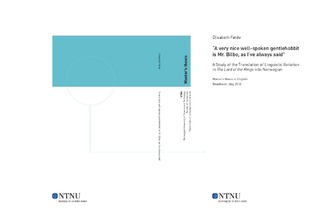| dc.description.abstract | This thesis examines which translation procedures have been used to translate linguistic variation in The Lord of the Rings into Norwegian, and sets out to test whether the results confirm the hypothesis that standardization is the predominant translation strategy for the translation of linguistic variation. The study is product-oriented and descriptive-explanatory, using a combination of qualitative and quantitative approaches to analyze 10 character samples from the novel, consisting of five different races and two characters for each racial category. The categorization of non-standard markers in Englund Dimitrova (2004) and categorization of translation procedures in Rosa (2012) were used as a framework for the analysis. A low and a high kind of non-standardness were found in the source text, and a varying amount of translation procedures was found in the two bokmål translations and the nynorsk translation examined. The translation procedures have been used in the following order in all three translations, from most to least used: addition, omission, maintenance and change. The results show that the first bokmål translation (TT1) has the highest number of omissions, while this number is somewhat lower in the second bokmål translation (TT2) and even lower in the nynorsk translation (TT3). Omission is a move towards standardization, meaning that non-standard varieties become more like the standard language, and the high amounts of omissions can therefore be evidence of standardization in the translations. However, the high amounts of additions in all TTs, especially TT3, as well as a few changes, can be seen to function as compensations for the omissions. Additionally, there are some amounts of maintenance in the translations, and these three translation procedures can be said to be a counterpart to omission, since they either transfer non-standardness into a TT or contribute with even more non-standardness in a TT. Adding the numbers of additions, changes and maintained markers together, all three translations have more non-standard markers than the ST, which can be evidence of a move away from standardization. Nevertheless, it is difficult to confirm or disprove the standardization hypothesis, due to the different opinions regarding additions and changes being compensations for omissions in translation. | nb_NO |
